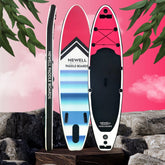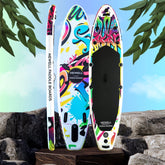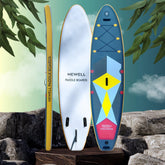How to paddleboard safely in a river?
How to paddleboard safely in a river?
Paddleboarding on a river can be a thrilling and peaceful experience, connecting you with nature in a unique way. Whether you're a beginner or an experienced paddleboarder, it's essential to prioritize safety to ensure a memorable and enjoyable adventure. In this blog, we will guide you through essential safety tips and precautions, helping you paddleboard safely on the river while embracing the beauty of nature that surrounds you.
1- Choose the Right Equipment
Selecting the appropriate paddleboard and gear is the first step toward a safe and enjoyable river paddleboarding experience. Here are a few considerations to keep in mind:
- Paddle Board: Opt for a board designed to handle rough waters and rocky shorelines. Low-bearing paddleboards and longboards will not perform as efficiently on the water compared to shorter boards. All Newell Outdoors paddleboards are designed with river paddling in mind; therefore, they can handle rough terrain without popping or getting punctured and can perform very well in rapids, allowing for a smooth, less physically demanding ride.
- Paddle: Ensure you have an adjustable paddle that suits your height and provides a comfortable grip.
- Personal Flotation Device (PFD): Always wear a well-fitted PFD. Even if you're an excellent swimmer, unexpected circumstances can arise, and a PFD can be a lifesaver.
- Safety Leash: Attach a leash to your ankle or calf and secure it to the board. This prevents the board from drifting away if you fall into the water.
- Protective Gear: Depending on the conditions, consider wearing a helmet, especially when navigating rocky areas or white-water rapids.
2- Research and Assess the River
Before embarking on your river paddleboarding journey, conduct thorough research to familiarize yourself with the river's characteristics. Here are some factors to consider:
- Water Flow and Currents: Understand the river's flow and its potential changes throughout the day. Strong currents can make paddling challenging, so ensure you have the necessary skills to handle them.
- Hazards and Obstacles: Learn about any potential obstacles, such as rocks, fallen trees, or rapids along your route. Knowing their locations helps you plan your path accordingly.
- Weather Conditions: Check the weather forecast before heading out. Wind, rain, and storms can affect the river's conditions, making it unsafe for paddleboarding.
- Local Regulations: Familiarize yourself with any local rules or regulations regarding paddleboarding on the river. Some areas may have restrictions or guidelines to follow.
3- Master Paddleboarding Techniques
To paddleboard safely on the river, it's crucial to have a good grasp of basic paddleboarding techniques. Here are some key techniques to practice and master:
- Balance and Stance: Find your balance on the board by placing your feet hip-width apart and keeping your knees slightly bent. Distribute your weight evenly to maintain stability.
- Paddling Technique: Use an efficient paddling technique by reaching forward with the paddle blade, submerging it fully in the water, and pulling it back to propel yourself forward. Practice alternating sides to maintain a straight course.
- Maneuvering: Learn how to turn the board by paddling on one side more than the other. Use sweeping strokes or back-paddling to navigate obstacles or change direction swiftly.
- Falling and Getting Back On: Falling off the board is a normal part of paddleboarding. Learn how to fall safely away from your board, and practice getting back onto it efficiently.
- River Navigation: Understand river signals and basic river navigation techniques, such as eddies and ferrying, which allow you to navigate currents and obstacles effectively.
4- Safety Precautions on the River
When paddleboarding on the river, safety should always be a priority. Here are essential precautions to follow:
- Buddy System: Paddle with a companion whenever possible. Having someone nearby enhances safety and adds to the fun of the experience.
- Check Water Conditions: Observe the river's conditions carefully before entering the water. Look for signs of strong currents, debris, or changes in water level. If conditions appear unsafe, it's best to postpone your paddleboarding adventure.
- Dress Appropriately: Wear appropriate clothing for the weather conditions. Consider a wetsuit in colder temperatures, and apply sunscreen to protect your skin from the sun's rays.
- Hydration and Nutrition: Bring water and snacks to stay hydrated and energized throughout your paddleboarding trip. Dehydration can lead to fatigue and decreased concentration.
- Stay Aware and Alert: Keep an eye on your surroundings and be aware of other watercraft or potential hazards. Stay alert and avoid distractions to maintain your safety.
- Learn Basic First Aid: It's beneficial to have knowledge of basic first aid techniques, including CPR and treating minor injuries. Carry a first aid kit with you in case of emergencies.
Paddleboarding on the river is a thrilling and serene adventure that allows you to explore nature's beauty while engaging in physical activity. By following these safety tips and precautions, you can ensure a safe and exciting experience on the river. Remember to choose the right equipment, research the river's characteristics, master paddleboarding techniques, and prioritize safety at all times.












